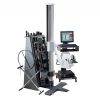
New Upper Extremity Techniques and CPT Coding
BTE System GuidesBecause the Simulator II is so flexible, clinical researchers have found creative ways to use it for diagnosis, evaluation, and treatment. We’re sharing examples of these applications so you can get the most out of your Simulator II.
Hand therapists, raise your hands! We want you to get the most out of your BTE equipment. That means exploring new ways to use it with patients and strategic coding.
If your clinic already works with our Simulator II, chances are, you know how to use it for treatment of common conditions. But what about diagnosis and evaluation? Or treatment for conditions you haven’t used it for yet?
Because the Simulator II is so flexible, clinical researchers have found creative ways to use it for diagnosis, evaluation, and treatment. We’re sharing examples of these applications so you can get the most out of your Simulator II.
Diagnosing Carpal Tunnel Syndrome
Researchers Braun et al used the Simulator II to diagnose carpal tunnel syndrome. Patients presented with numbness and tingling when performing certain tasks with their hands. They used the Simulator II for repeated gripping, turning a screwdriver, and pinching while pronating and supinating1.
The Simulator II allows you to observe your patients’ real-life activities in the clinic. If your patient performs these activities and gets the tingling and numbness, they may have carpal tunnel syndrome.
Diagnosing Thoracic Outlet Syndrome (TOS)
Braun et al also used the Simulator II for patients with suspected thoracic outlet syndrome (TOS). Patients performed activities normally, then used anterior scalene muscle blocks.
They did push-pull tests with the arms at waist level and overhead, as well as repetitive gripping during static arm elevation. Measurements tracked their work product, time to fatigue, and power output with and without. Increased work and power with the muscle block indicates potential TOS1.
Evaluating Rotator Cuff Injuries
In addition to diagnosing conditions, the Simulator II can evaluate your patients’ current capabilities. The Simulator II’s evaluation protocol measured maximum strength, power output, and endurance.
One research group used the Simulator II to evaluate patients after rotator cuff repair. Raschhover et al tested different therapy methods on two groups of recovering patients2.
Following the different therapy methods, both groups performed the same activities on the Simulator II. Performing activities on the Simulator II would yield different strength outcomes for each group. They tested max strength of the rotator cuff in isometric mode using tool 8022.
Evaluating Pisiform Removal Recovery
Two different groups of researchers used the Simulator II to evaluate patients after removal of the pisiform bone from the wrist.
Campion et al evaluated strength throughout recovery using isometric and isotonic testing. They used Simulator II attachment 701 for wrist flexion3.
The other group, Lam et al, also tested both isometric and isotonic movements. They evaluated ulnar deviation with attachment 3024.
Treating Triangular Fibrocartilage Injuries (TFCC)
With the Simulator II’s high level of control, you can safely introduce risk factors to recovering patients. Researchers Pitts and Burgess gradually eased TFCC patients into challenging movements.
In late stages of TFCC rehabilitation, these patients safely performed radial and ulnar deviation, pronation and supination. With the Simulator II, they could begin movements that directly stress the injury site5.
This is an awesome idea! You can use the equipment to gradually introduce risky movements and build your patients’ strength and confidence.
Treating Nerve Transfers
Especially for nerve transfers, task-oriented activities most effectively pattern new movements. Kahn et al treated patients with nerve transfers from the triceps branch to the axillary nerve. The Simulator II’s “functional orientation and repetitive nature” encouraged neural flexibility and muscular reeducation6.
CPT Coding with the Simulator II
In a previous post, we shared a cheat sheet for strategic coding BTE equipment. If you use the diagnosis, evaluation, or treatment methods above, you’ll want to code them appropriately. All three of these codes are time-based (15 minutes):
- For therapeutic exercises to develop strength and endurance, range of motion, and flexibility, code CPT 97110
- For neuromuscular reeducation, code CPT 97112
- For dynamic exercises to improve functional performance with direct patient contact, code CPT 97530
How do you use your Simulator II? If you have a patient success story or a unique method at your clinic, we want to hear from you! Your story could be featured on our blog. Click below to share your ideas.
References:
- Braun RM, Shah KN, Rechnic M, et al. Quantitative assessment of scalene muscle block for the diagnosis of suspected thoracic outlet syndrome. J Hand Surg Am. 2015; article in press. http://dx.doi.org/10.1016/j.jhsa.2015.08.015.
- Raschhofer R, Poulios N, Schimetta W, et al. Early active rehabilitation after arthroscopic rotator cuff repair; a prospective randomized pilot study. Clin Rehabil. 2017;31:1332-1339. DOI: 10.117/026921551769431.
- Campion H, Goad A, Rayan G, et al. Pisiform excision for pisotriquetral instability and arthritis. J Hand Surg. 2014;39(7):1251-1257.
- Lam KS, Woodbridge S, Burke FD. Wrist function after excision of the pisiform. J Hand Surg (EU). 2003;28B:69-72.
- Pitts G, Burgess R. Triangular fibrocartilage injuries. In Burke SL, Higgins J, McClinton MA, Saunders RJ, Valdata L, (eds). Hand and Upper Extremity Rehabilitation: A Practical Guide. (3rded). St. Louis, MO: Elsevier Churchill Livingstone; 2006:475-487.
- Kahn LC, Moore AM.Donor activation focused rehabilitation approach – maximizing outcomes after nerve transfers. Hand Clin. 2014;32:263-277. http://dx.doi.org/10.1016/j.hcl.2015.12.014.





